Gram for gram, few birds are tougher and more aggressive than wrens.
The wren family lives mostly in the Americas. There are 79 species of wren in the Western Hemisphere. One small bird made it across the Siberian land bridge and is now found across Eurasia.
Here in Oregon we have several species: rock, canyon, Bewick’s, house, Pacific. Each wren is small, intense, vocal. Their songs are all rapid, musical, oft-repeated.
A wren can make even hummers and siskins seem meek and calm. Recently I met a couple of marsh wrens at Fairview Wetlands here in Salem. Not sure if they’ll stay for nesting season this spring.
They were singing and declaring ownership. “Marshy Law” as they see it: the marsh belongs to the wrens. Red-winged blackbirds be cursed and evicted. To do so the wrens attack red-wing nests, breaking eggs. This usually drives red-wings out of a marsh that the wrens want.
To suit marsh wrens, there needs to be standing water most of the summer. Red-wings are far more adaptable and nest up in trees if necessary.
Marsh wren nests are nearly impermeable unless you are an otter or other strong creature. They build tightly woven globes of cattail leaves and other handy construction material. Marsh wrens are among the few American birds that build enclosed nests, joining dippers, orioles, sedge wren, Bushtits. These are never as safe as nests in tree cavities or man-made nest boxes, but they’re often good enough.
It is skill, energy and attitude that makes a marsh wren, which weighs less than half an ounce. A six-inch wingspan is above a long and thin tail. A sharp arched beak is a crucial tool – or weapon. A predator eating mostly aquatic insects, this bird is an active presence in chosen Oregon marshes year round.
Listen for the wren music at your favorite cattail marsh as spring begins. His song is full of life, promise and pride. It is his marsh, after all.
Listen to one of many marsh wren song recordings.


For information about upcoming Salem Audubon programs and activities, see www.salemaudubon.org, or Salem Audubon’s Facebook page.
Harry Fuller is an Oregon birder and natural history author of “Freeway Birding.” He is a member of the Salem Audubon Society. Contact him at [email protected] or atowhee.blog. His “Some Fascinating Things About Birds” column appears regularly in Salem Reporter.

Harry Fuller is an Oregon birder and natural history author of three books: “Freeway Birding,” "Great Gray Owls of California, Oregon and Washington," and "San Francisco's Natural History--Sand Dunes to Streetcars." He leads birding trips for the Malheur Field Station. He is a member of the Salem Audubon Society, and leads bird trips locally. Harry has just published a new book, BIrding Harney County.









